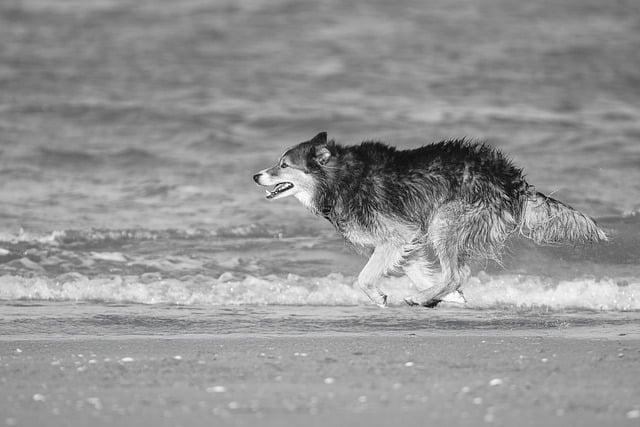In a quiet suburban neighborhood, a golden retriever named Max eagerly awaited his owner’s return. Each day, as the clock struck five, he would wag his tail furiously, bark with excitement, and race to the door. This joyful routine is a normal behavior in dogs, showcasing their loyalty and affection. Understanding these behaviors—like tail wagging, playful barking, and even the occasional zoomies—can deepen our bond with our furry friends. By recognizing and nurturing these instincts, we create a happier, healthier environment for our beloved pets.
Contents
- Understanding Canine Communication and Body Language
- Recognizing Playful Interactions and Socialization Needs
- Establishing Healthy Routines for Exercise and Mental Stimulation
- Identifying Signs of Stress and Anxiety in Dogs
- Q&A
Understanding Canine Communication and Body Language
Understanding how dogs communicate is essential for any pet owner. Dogs express their feelings and intentions through a combination of vocalizations and body language. Recognizing these signals can help you respond appropriately to your dog’s needs and emotions. For instance, a wagging tail is often seen as a sign of happiness, but the position and speed of the wag can convey different messages. A slow wag might indicate uncertainty, while a fast, high wag usually signifies excitement.
Body posture plays a crucial role in canine communication. When a dog stands tall with its ears perked up, it typically indicates confidence and alertness. Conversely, a dog that crouches low with its tail tucked may be feeling fearful or submissive. Understanding these subtle cues can help you gauge your dog’s mood and adjust your interactions accordingly. For example, if your dog displays a defensive stance, it may be best to give them space rather than approaching them directly.
Vocalizations are another key aspect of how dogs communicate. Barking, growling, whining, and howling each serve different purposes. A sharp bark might signal a warning, while a series of barks could indicate excitement or playfulness. Whining often reflects anxiety or a desire for attention. By paying attention to the context in which these sounds occur, you can better interpret what your dog is trying to convey and respond in a way that reassures them.
Lastly, the environment plays a significant role in canine behavior. Dogs are highly attuned to their surroundings and can react to changes in their environment. For example, a dog may become more alert and focused in a busy park compared to a quiet home. Understanding how your dog interacts with different settings can help you create a more comfortable and enriching environment for them. By fostering an awareness of your dog’s communication style, you can strengthen your bond and ensure a happier, healthier life together.
Recognizing Playful Interactions and Socialization Needs
Understanding the playful interactions and socialization needs of dogs is essential for fostering their well-being and happiness. Dogs are inherently social animals, and their behaviors often reflect their desire for companionship and engagement. Observing how your dog interacts with other dogs and humans can provide valuable insights into their social skills and emotional health. Playful behaviors, such as chasing, wrestling, and playful barking, are not just fun; they are crucial for developing social bonds and learning appropriate communication cues.
When dogs engage in play, they exhibit a range of behaviors that signal their intentions and emotions. **Tail wagging**, **play bows**, and **soft body language** are all indicators that your dog is ready to engage in a friendly interaction. It’s important to recognize these signs, as they demonstrate your dog’s comfort level and willingness to socialize. Encouraging these playful interactions can help build confidence and reduce anxiety, making your dog more adaptable in various social settings.
Socialization is not limited to interactions with other dogs; it also includes exposure to different environments, people, and experiences. Regularly introducing your dog to new situations can enhance their adaptability and reduce fear-based behaviors. Activities such as visiting dog parks, attending training classes, or simply taking walks in diverse neighborhoods can provide enriching experiences that contribute to your dog’s social development. **Positive reinforcement** during these interactions can further strengthen their ability to navigate social situations with ease.
It’s essential to monitor your dog’s play interactions to ensure they remain positive and healthy. Look for signs of stress or discomfort, such as growling, snapping, or retreating, which may indicate that the play has become overwhelming. Providing a safe space for your dog to retreat to when needed can help them feel secure. By fostering an environment that encourages healthy socialization and playful interactions, you can significantly enhance your dog’s quality of life and strengthen the bond you share.
Establishing Healthy Routines for Exercise and Mental Stimulation
Establishing a consistent routine for exercise and mental stimulation is essential for your dog’s overall well-being. Dogs thrive on structure, and incorporating regular physical activity into their daily lives not only helps maintain a healthy weight but also reduces the risk of behavioral issues. Aim for at least 30 minutes to an hour of exercise each day, depending on your dog’s breed, age, and energy level. This can include walks, playtime in the yard, or engaging in dog sports.
In addition to physical exercise, mental stimulation is equally important for your dog’s happiness and health. Dogs are intelligent creatures that require challenges to keep their minds sharp. Incorporating activities that stimulate their cognitive abilities can prevent boredom and destructive behaviors. Consider the following options:
- Interactive toys: Puzzle feeders and treat-dispensing toys can keep your dog engaged while rewarding them for their efforts.
- Training sessions: Regular training not only reinforces good behavior but also provides mental challenges that can be both fun and rewarding.
- Socialization: Arranging playdates with other dogs or visiting dog parks can provide both physical exercise and mental engagement through social interaction.
Establishing a routine that combines both exercise and mental stimulation can significantly enhance your dog’s quality of life. Dogs that receive adequate physical activity are less likely to exhibit anxiety or destructive behaviors, leading to a more harmonious home environment. Additionally, mental challenges can help strengthen the bond between you and your dog, as you work together to solve problems and learn new skills.
Remember, every dog is unique, and their needs may vary. Pay attention to your dog’s responses to different activities and adjust their routine accordingly. By prioritizing both physical and mental health, you are not only ensuring your dog leads a fulfilling life but also fostering a deeper connection that enriches your relationship. A well-exercised and mentally stimulated dog is a happy dog, and that happiness will reflect in your home.
Identifying Signs of Stress and Anxiety in Dogs
Understanding your dog’s emotional state is crucial for their overall well-being. Dogs, like humans, can experience stress and anxiety, and recognizing the signs early can help you provide the necessary support. One of the most common indicators is **excessive barking**. If your dog suddenly starts barking more than usual, it could be a response to stressors in their environment.
Another sign to watch for is **changes in body language**. A dog that is feeling anxious may exhibit behaviors such as cowering, tucking their tail between their legs, or avoiding eye contact. These physical manifestations can be subtle but are essential cues that indicate your dog may not be feeling secure. Additionally, **panting or pacing** can also signal discomfort or unease, especially if these behaviors occur without physical exertion.
Changes in appetite can also be a red flag. If your dog suddenly loses interest in food or, conversely, starts eating excessively, it may be a sign of emotional distress. **Destructive behavior**, such as chewing furniture or digging, can also indicate that your dog is trying to cope with anxiety. These actions are often a cry for help, signaling that your furry friend needs attention and reassurance.
Lastly, **withdrawal from social interactions** can be a significant indicator of stress. If your dog, who usually enjoys playtime or cuddling, begins to isolate themselves, it’s essential to take notice. Providing a calm and safe environment, along with positive reinforcement, can help alleviate their anxiety. By being attentive to these signs, you can foster a healthier and happier life for your canine companion.
Q&A
-
What are some typical behaviors of a healthy dog?
Normal behaviors in dogs include:
- Playfulness and energy during interactions.
- Curiosity about their environment.
- Affectionate bonding with their owners.
- Regular eating and drinking habits.
-
How do dogs communicate their needs?
Dogs communicate through various behaviors, such as:
- Barking to signal attention or alertness.
- Whining when they seek comfort or need something.
- Body language, like wagging tails or raised hackles, to express emotions.
- Following their owners closely to indicate attachment or need for companionship.
-
What are signs of stress or anxiety in dogs?
Common signs of stress or anxiety include:
- Excessive barking or whining.
- Destructive behavior, such as chewing furniture.
- Hiding or seeking isolation.
- Changes in eating or sleeping patterns.
-
How can I encourage normal behaviors in my dog?
To promote healthy behaviors, consider:
- Providing regular exercise and playtime.
- Establishing a consistent routine for feeding and walks.
- Socializing your dog with other pets and people.
- Offering positive reinforcement for good behavior.
In understanding normal dog behaviors, we foster deeper connections with our furry companions. By recognizing their needs and instincts, we can enhance their well-being and strengthen our bond. Embrace these insights for a happier, healthier dog.

大家好,我是彼得潘,專業的手法身體治療師。我喜歡探索和研究各種主題,並透過與人工智慧的合作分享專業、實用、有趣的文章。我們定期進行人工審核,以確保內容的準確性。如果您發現文章中有任何不準確的地方,請隨時與我們聯繫,我們會及時糾正。您可以透過 [email protected] 與我們聯繫。



